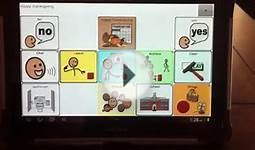Nonverbal communication devices
For over 40 years voice output devices have been used to help individuals with developmental and acquired disabilities to communicate successfully. Voice output devices offer tremendous promise in helping nonverbal individuals with autism overcome their unique communication barriers. The auditory output provides one more sensory feedback to help the child develop his receptive and expressive language skills. Other advantages of voice-output communication devices are explained below.
Clarity of Communication
The key advantage to voice output devices is that the device allows the individual to "talk" which lets the communication partner understand exactly what is being expressed. Methods of AAC that don't have voice output may be difficult for the untrained communication partner to understand, increasing frustration for both the AAC communicator and those with whom he or she is trying to communicate. The auditory output also provides feedback to the device user so he can determine if what he said was actually what he meant to say.
There is also evidence suggesting that pairing the communicated word with voice output may help the child with auditory processing of spoken language.
Expressive language can lead to improved receptive language
Babies start attaching meaning to the sounds that they make through our responses to their babbling. When they babble "mama" and their mother responds with claps, smiles, and kisses, they slowly start to learn what "mama" means. The same process can occur with an AAC device. When the child says a word and we provide a response, he can start attaching meaning to the spoken word. Even when no communication partner is present, the child has the ability to learn words through the auditory output.

Supports Motor Learning/Sensory Integration Principles
We learn new motor skills by attending to and integrating the sensory input related to the task. This involves problem solving or motor planning how to accomplish the task, executing the task, assessing our performance and making modifications for future success.
When this process is interrupted, learning is difficult. Verbal speech is a very complicated task. Neurological issues associated with autism (i.e. sensory processing disorders, sensory integration issues, distractibility, and apraxia) may interfere with any or all aspects of this motor learning process.
You might also like








